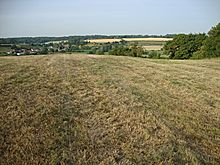|
|
|
|
Barrow Hill (Buckland Dinham)Long Barrow
|
||||||||||||||||||||||||
|
|
|
Images (click to view fullsize) |
|
Photographs:




 Maps / Plans / Diagrams:
Maps / Plans / Diagrams:
|
Fieldnotes |
|
|
I was fortunate enough to visit this site in low light which showed up a depression where the barrow was reported to stand. If the reports of it being constructed as a 'vaulted tumulus' similar to Stoney Littleton are correct, the chambers may have extended into the hill. Not much to see here but I could clearly make out the Murtry Hill stones (see picture) There was a map of the site by the cycle path but I got the impression that the Saxon cemetery and the position of the Long Barrow had been swapped to put off anybody who might use a metal detector. Buckland colliery is situated on the opposite side of the hill from the barrow site. Two shafts were sunk in 1879 but they filled with water and no coal was ever produced. The long barrow may have been built over a blind well connecting an underground waterway. ACCESS The easiest and quickest route to this site is via the footpath at ST 75083 49920, just past the Great Elm railway bridge. The barrow was situated at the top of the hill, behind what is now a wooded area, but was originally the old quarry mentioned in the Pastscape record. Decided I would take the longer but downhill walk to this site. Can't say I would recommend it to anyone else who would choose to visit, unless they had the time, as it was much easier to visit from the gate by Great Elm. |
 Posted by Chance
Posted by Chance2nd February 2014ce |
Folklore |
|
John Strachey quoted 'an old Tradition that 2 Kings had a Battle, the one being possessed of ye hill, I presume Tedbury, made a great slaughter of ye Other in Murders bottom* which is under Tedbury from rolling stones upon them and hanged ye Prisoners in Hangmans Lane whence they brought ye Stones and heaped them over ye dead in ye West Feild barrow.'From the late great L V Grinsell, in 'Somerset Barrows- Revisions 1971-87', volume 131 (1987) of Som Arch Nat Hist journal. *Now Murder Combe on the OS map. |
 Posted by Rhiannon
Posted by Rhiannon24th April 2006ce Edited 24th April 2006ce |
Miscellaneous |
|
|
Details of Long Barrow on Pastscape A Saxon inhumation cemetery recorded on Barrow Hill. The cemetery comprises five or six burials one of which was a inhumation orientated northwest-southeast and accompanied by grave goods included two silver wire rings and amethyst, glass and shell beads. The presence of the amethyst beads dates the burial to the seventh or early eighth century. The cemetery is situated close to the site of a chambered long barrow which was robbed for road materials during the early 19th century. Earthworks, possibly upcast from quarrying, have been described as the remains of a round barrow. [ST 74875025] ANGLO-SAXON BURIAL GROUND [GT]. (1) A Pagan Anglo-Saxon burial, probably 6th century, was found in August 1925, in a small quarry on the south side of Barrow Hill, Buckland and Dinham. Four or five other burials have been found previously. The grave was examined by the Rev. Horne in company with A. Buleid. It contained a female skeleton, two rings of fine silver were, possibly earrings, and half a dozen beads in quartz, glass and white shell. The beads were dated by the British Museum. (R.A. Smith). (2) In addition to the above other human bones were found in June 1923 and earlier (a). These burials have been sited by H. St. G. Grey to ST 74845027 (b), a position that coincides with a small overgrown quarry and is probably more accurate than the O.S. siting. Skinner states that quantities of human bones were found when a 'vaulted tumulus' similar to Stoney Littleton (a chambered long barrow, ST 75 NW 16) was robbed for road materials in the early 19th century. This barrow seems to have been situated at the east end of the hill (c), possibly at ST 74825030 where there is a slight, apparently natural, rise at the end of the spur. Wicks records a round barrow, 4 foot 6 inches high and 31 feet in diameter, in a small thorn copse just below the point of the spur and 30 yards from the quarry where Saxon skeletons were found. (c) He is almost certainly referring to an irregular mound 0.9m. high at ST 74875026 which has no ditch and appears to be upcast from nearby surface quarrying. (3) Anglo-Saxon burials - additional reference (4) Barrows - additional references (5-7) Additional reference (8) |
 Posted by Chance
Posted by Chance20th January 2014ce |
|
Perhaps there were once quite a few long barrows in this area - there was definitely the one at Fromefield, and there may have been one here 'opposite' Murtry Hill - on the hill suspiciously named 'Barrow Hill'. In 1825 B M Skinner wrote of the latter: "a vaulted tumulus similar to that at Stoney Littleton, which has been nearly destroyed for the sake of procuring materials for the roads, and where quantities of human bones were found." An earlier commentator, Strachey, refers to the barrow in 1737: "..here is a stone 8ft long and 2ft square now lying down but probably upright formerly..". Anglo-Saxon burials were found in the same kind of area in the 1920s, but if anything wouldn't it be that they were reusing an older burial site - the Anglo-Saxons didn't go in for 'stone vaulted tumuli'? Info gleaned from the Somerset Historic Environment Record at http://webapp1.somerset.gov.uk/her/sop.asp?flash=true |
 Posted by Rhiannon
Posted by Rhiannon7th December 2004ce Edited 2nd July 2005ce |

